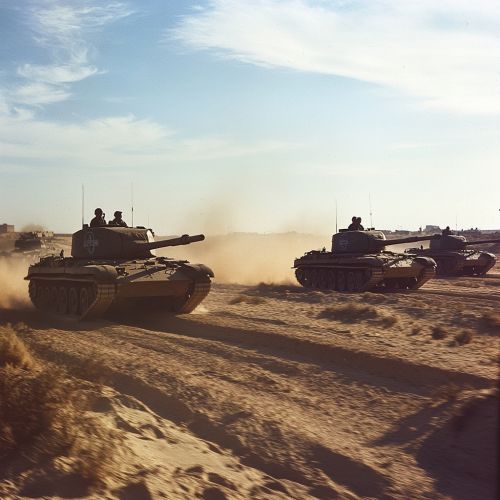Battle of El Alamein
Battle of El Alamein
The Battle of El Alamein was a pivotal confrontation during the Western Desert Campaign of World War II, fought in North Africa between the Axis forces, led by Field Marshal Erwin Rommel, and the Allied forces, commanded by General Bernard Montgomery. This battle is often divided into two main phases: the First Battle of El Alamein (July 1-27, 1942) and the Second Battle of El Alamein (October 23 - November 11, 1942). It marked a significant turning point in the North African campaign, halting the Axis advance into Egypt and securing the Suez Canal for the Allies.
Background
The North African Campaign began in 1940 when Italian forces invaded Egypt from their colony in Libya. The British counterattacked, pushing the Italians back into Libya. In response, Germany sent the Afrika Korps under Rommel to aid their Italian allies. Rommel's aggressive tactics led to a series of victories, culminating in the capture of Tobruk in June 1942. The Axis forces then advanced towards Egypt, aiming to seize the Suez Canal and cut off Allied supply lines.
First Battle of El Alamein
The First Battle of El Alamein took place from July 1 to July 27, 1942. The Axis forces, consisting of German and Italian troops, sought to break through the British defenses and advance into Egypt. However, the Allied forces, under the command of General Claude Auchinleck, managed to halt the Axis advance. The battle resulted in a stalemate, with both sides suffering heavy casualties.
Interlude
Following the First Battle of El Alamein, both sides regrouped and reinforced their positions. In August 1942, General Bernard Montgomery took command of the British Eighth Army. Montgomery implemented a rigorous training program and improved the logistical support for his troops. Meanwhile, Rommel faced supply shortages and increasing pressure from the Allied air forces.
Second Battle of El Alamein
The Second Battle of El Alamein began on October 23, 1942, with a massive artillery barrage by the Allied forces. Montgomery's plan, codenamed Operation Lightfoot, aimed to breach the Axis defenses and encircle their forces. The battle was characterized by intense fighting, with both sides employing tanks, artillery, and infantry in a series of engagements.


Phase One: The Break-In
The initial phase of the battle, known as the Break-In, involved a frontal assault on the Axis defensive lines. The Allied forces, supported by extensive artillery and air support, managed to penetrate the minefields and fortifications. However, progress was slow, and the fighting was fierce.
Phase Two: The Crumbling
The second phase, called the Crumbling, saw the Allies exploiting their initial gains. Montgomery's forces launched a series of attacks to wear down the Axis defenses. The use of combined arms tactics, including coordinated assaults by infantry, tanks, and artillery, gradually weakened the Axis positions.
Phase Three: The Break-Out
The final phase, the Break-Out, began on November 2, 1942. The Allies launched a decisive attack, breaking through the remaining Axis defenses. Rommel, recognizing the untenable situation, ordered a retreat. The Allied forces pursued the retreating Axis troops, capturing thousands of prisoners and securing a significant victory.
Aftermath
The victory at El Alamein marked a turning point in the North African Campaign. It boosted Allied morale and demonstrated the effectiveness of Montgomery's leadership and tactics. The Axis forces, now in full retreat, were pursued across Libya and eventually expelled from North Africa in May 1943. The battle also had strategic implications, securing the Suez Canal and maintaining Allied control over the Mediterranean.
Significance
The Battle of El Alamein is often cited as one of the key turning points of World War II. It marked the beginning of the end for the Axis presence in North Africa and paved the way for the Allied invasion of Italy. The battle showcased the importance of logistics, air superiority, and combined arms tactics in modern warfare.
